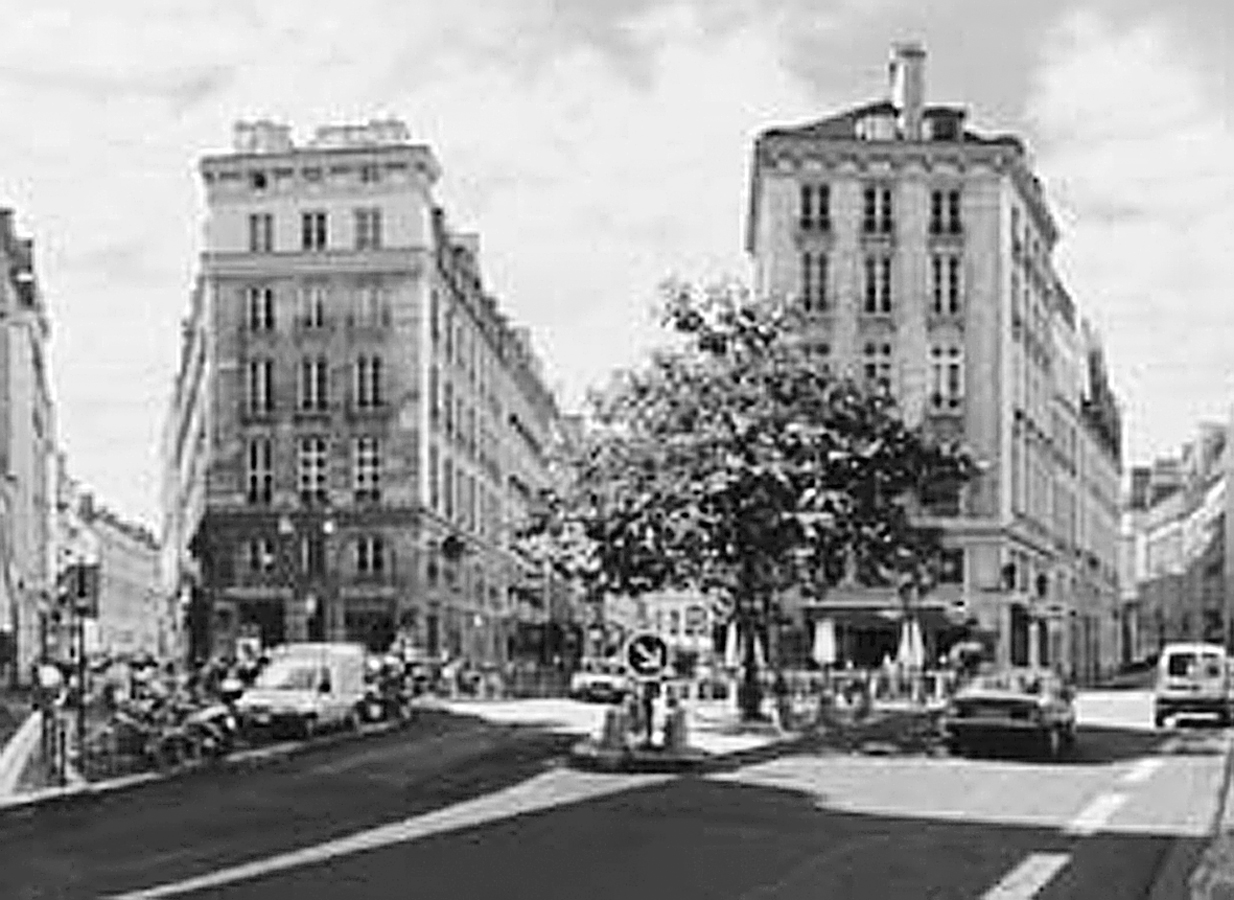THE FOOT OF OUR STREET, RUE DE L’ODÉON, CONVERGES WITH RUE de Condé, rue Monsieur-le-Prince, and boulevard Saint-Germain to create an open space, the Carrefour (crossroads) de l’Odéon. Bars and restaurants line the square, and just around the corner on the boulevard three cinema complexes attract long queues most afternoons and nights.
When I first moved to Paris, drivers—particularly on Saturday nights—would park around the square but also in the middle, leaving almost no space for traffic to pass. In summer, cars blocked the square and even edged onto the sidewalk as families abandoned them to stroll up to the Luxembourg Gardens. Occasional raids by the pervenches (periwinkles), as traffic policewomen were called because of their blue uniforms, didn’t deter them. A few papillons (butterflies), slang for “traffic tickets,” were regarded as part of the price of city living—and besides, in August no tickets were issued, since the pervenches were on holiday like almost everyone else.
Just when it seemed the city government was helpless to solve this problem, it intervened in a manner that was decisive, original, and entirely in tune with the traditions of Paris.
One Monday morning, a truck dumped slabs of stone in the middle of the square. Workers appeared, and by lunchtime they had dug up the cobblestones laid during Paris’s reconstruction in the 1860s, exposed the subsoil, and created the beginnings of a traffic island. The next day they planted a tree, two or three meters tall and already in leaf.
By the end of the day, most of us had found a reason to walk down to the corner and stare at this addition to the neighborhood. A tree. Of course. Why hadn’t we thought of that? Had it been just a traffic island, drivers would have found a way to park on it, but a tree . . . As nobody on our street was intimate with any plant larger than a geranium, we had to look it up. It was a paulownia, specifically the Paulownia fortunei, or dragon tree, which promised to blossom with purple flowers in the spring.
The following Saturday evening, some of us contrived to be relaxing with an aperitif outside the cafés on the carrefour. We took quiet satisfaction as driver after driver swung off the boulevard in expectation of parking in his customary spot, only to halt, glare up at the tree, and, muttering to himself, drive on.
Today the paulownia, now five or six meters tall, dominates the intersection, its purple blossoms a feature of the quartier. They have inspired the hotel opposite to decorate each of its windows with a box of geraniums and greatly increased trade at local cafés and restaurants, introducing an accent of rural calm to one’s evening aperitif. During the publishers’ annual trade show, the Salon du Livre, people hang books from its branches, and on the Fête de la Musique, when amateur musicians are encouraged to exercise their creativity in public, a children’s choir performs under its shelter.

The Carrefour de l’Odéon, with paulownia tree.
Carrefour de l’Odéon.
One Sunday evening shortly after I finished writing this book, Marie-Dominique came home from having dinner with her mother showing more good humor than was usual after these often trying occasions.
“I read something at maman’s place,” she said, with the expression of the cat that has found the cream. “You know the carrefour?”
“Where they planted the tree?”
“Yes. Well, before they built the boulevard, that was the end of rue de l’Ancienne-Comédie. The cross street was called passage du Riche Laboureur, the Passage of the Rich Laborer.”
“And so . . . ?”
“Guess who lived at 12 rue de l’Ancienne-Comédie?”
We’d discussed the theme of this book often enough for me to see what was coming.
“Let me guess. Fabre d’Églantine?”
“Yes!”
“Well, it makes sense,” I mused, a little too unexcitedly. Marie-Dominique looked miffed, so I continued, “Danton lived just around the corner, and Desmoulins and Marat a few streets away. The Chapelle des Cordeliers is close too. But why the Rich Laborer?”
“It’s from La Fontaine. One of his fables. Maybe there was an inn there that used the name.”
Later, I looked up the story. Like most of La Fontaine’s cautionary tales, the French equivalent of Aesop’s Fables, it was in verse:
A wealthy farmer, feeling death draw nigh,
Called round his children, and, no witness by,
“Beware,” he said, “of selling the estate
Our fathers left us, purchased with their sweat;
For hidden treasure’s there.
The spot I know not; but with zeal and care
You’ll find it out, and make it yours at last.
Plough up the ground as soon as autumn’s past,
And dig and delve—nor grudge the daily pain;
And when you’ve toiled, return and toil again.”
He died. The sons turned up the field;
Incessant was their toil, and when the year
Was ended, large the produce it did yield,
Though ne’er a hidden treasure did appear.
Wise was the father, ere he died, to show
That labour is the mine whence riches flow.
It was almost too good to be true. For the author of the Republican calendar to live on a street that celebrated the rural virtues and to have the site of his former home marked by a tree—endings didn’t come more fortuitous than that. And when the children gathered under its branches for the Fête de la Musique, what were the odds they sang “Il pleut, bergère”?
Life in France is less about achievement than process. Hours, days, months, seasons, years pass, each with promises honored or thwarted, events celebrated or endured. The world turns, but France, like the pivot of Foucault’s pendulum, remains in its essentials unchanged. For such a culture the Republican calendar, preoccupied with nature and the seasons, may be, for all its faults, an apt metaphor and Philippe-François-Nazaire Fabre, however disreputable, a fitting laureate.